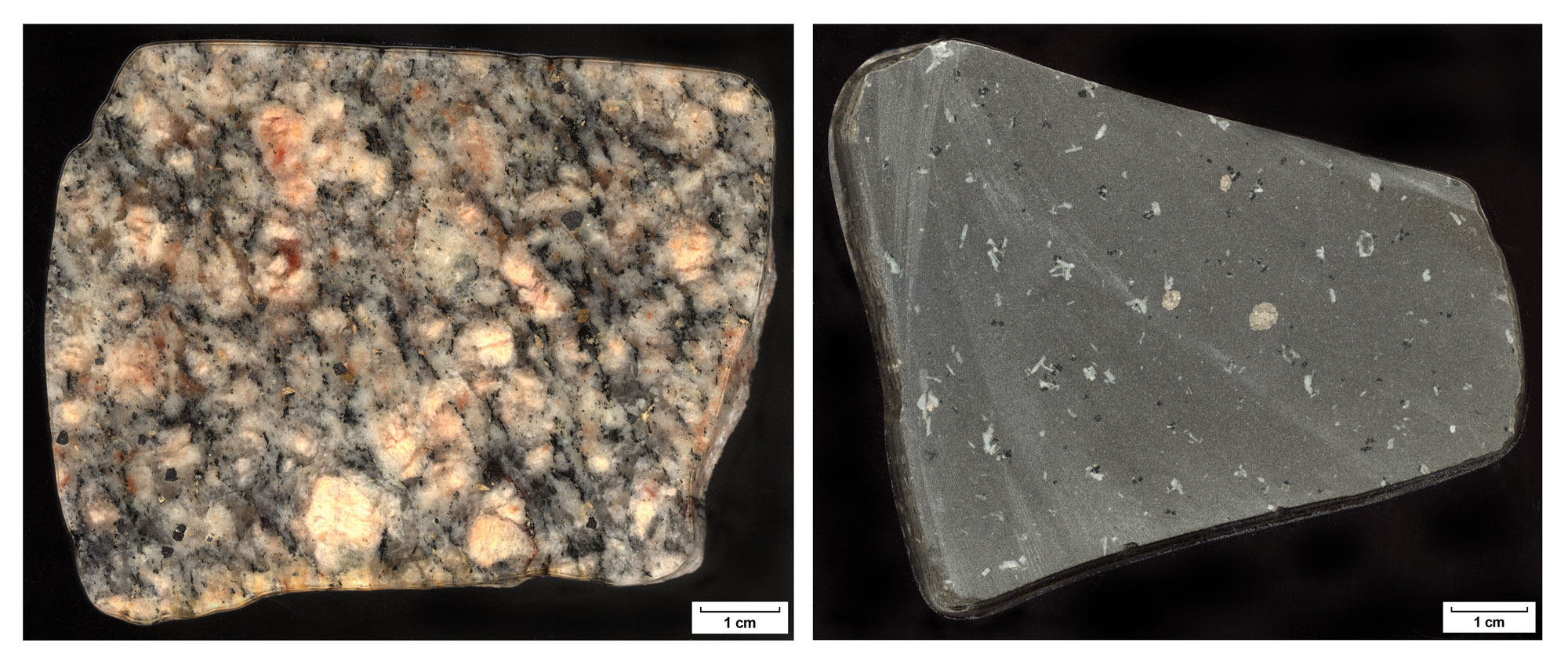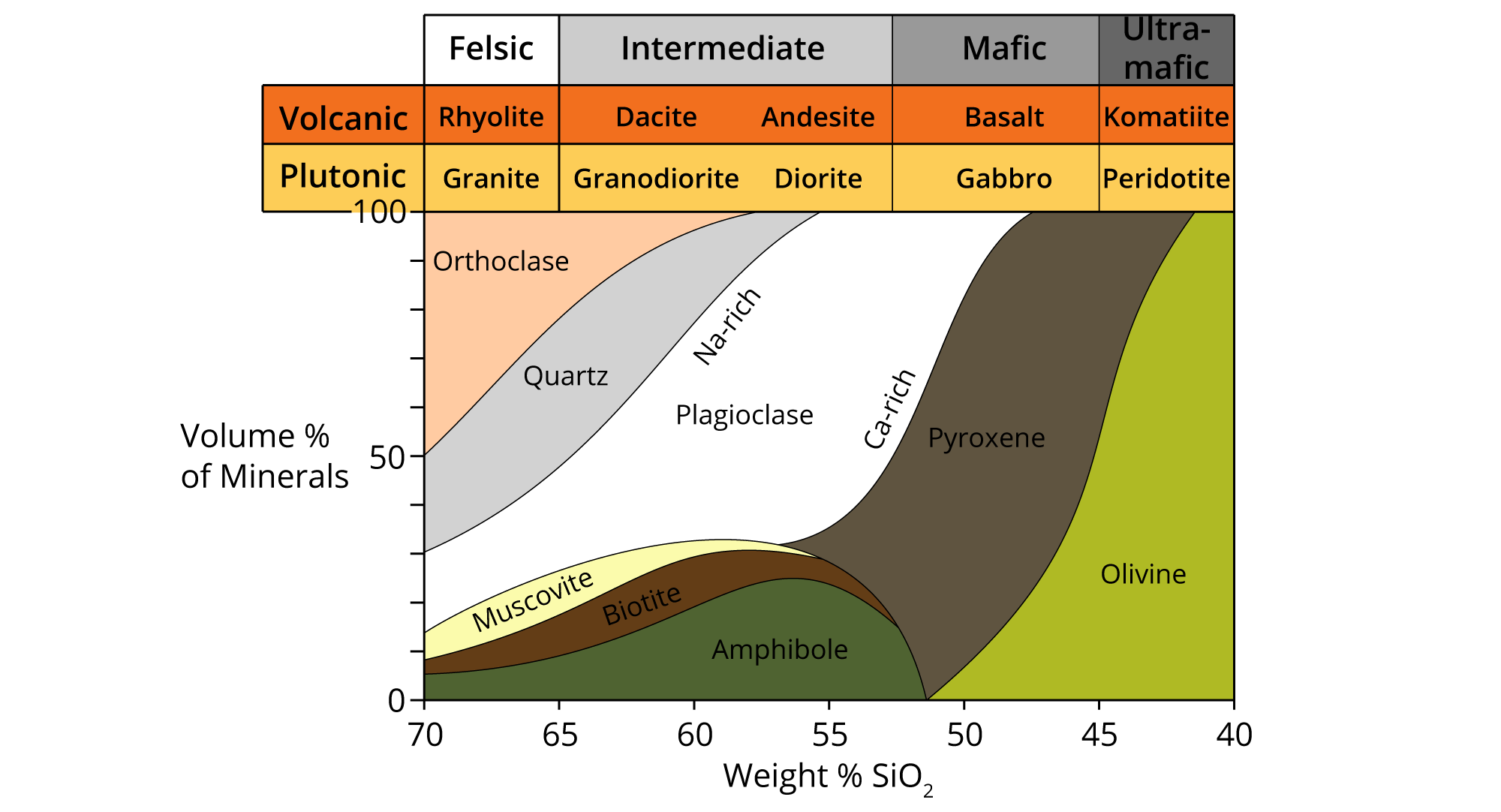Overview
Igneous rocks form from the cooling of magma (molten rock underground) or lava (molten rock at the Earth's surface). There are two major types of igneous rocks: plutonic and volcanic. These two major groups are differentiated based on whether they cooled above or below Earth's surface, which in turn dictates whether or not crystals are visible to the naked eye.
When magma cools slowly underground, it has time to produce large crystals that are visible to the naked eye. Rocks that form in this manner, such as granite, are called plutonic (or, intrusive igneous rocks). Most magma never reaches Earth's surface. When magma erupts the surface (as lava), it cools quickly so that individual crystals are not visible, resulting in a volcanic rock such as basalt (volcanics are also called extrusive igneous rocks). In some circumstances, lava may cool so quickly that crystals do not form at all, creating a glassy rock such as obsidian. Smaller fragmental rocks that cool quickly at the surface form during explosive eruptions; these are called pyroclastic rocks, and they are composed of a variety of different volcanic ejecta.
Classification of Igneous Rocks
At a broad scale, igneous rocks are classified based on two factors: texture and color.
Texture
Texture refers to the shapes and sizes of individual mineral crystals in an igneous rock, which is associated with the cooling times (igneous rocks with large crystals cooled slowly below Earth's surface, while those with small crystals cooled very quickly above the surface). There seven types of textures: aphanitic, phaneritic, pegmatitic, porphyritic, vesicular, glassy, and pyroclastic.
Table: Igneous rock textures.
| Texture | Description |
|---|---|
| Aphanitic | Fine-grained; individual crystals cannot be observed without a microscope. |
| Phaneritic | Individual crystals can be seen with naked eye; range from ~1-5 mm in size. |
| Pegmatitic | Individual crystals are very large; >1cm. |
| Porphyritic | Combination of visible crystals (=phenocrysts) and microscopic crystals (=groundmass). |
| Vesicular | Rock with holes (=vesicles) resulting from gases that were once trapped in the rock. |
| Glassy | Looks like amorphous glass; no visible crystals. |
| Pyroclastic | Rock containing fragments of other rocks and particles of glass. |
Color
Color, as the name suggests, refers to the overall color of a rock, which in turn is related to the different types of minerals that make up the rock.
Table: Igneous rock colors.
| Color | Description |
|---|---|
| Felsic | Light-colored; contain a lot of feldspar. |
| Intermediate | Intermediate (helpful, right?) |
| Mafic | Dark-colored; minerals include a lot of magnesium (Mg) and iron (Fe). |
| Ultramafic | Very dark colored rocks that likely contain a lot of the mineral olivine. |
As noted in the table above, felsic rocks are light in color because they contain lots of felspar and silica, which are light-colored minerals. The word mafic references the fact that these dense, dark rocks contain lots of magnesium (Mg) and iron (Fe), but low amounts of silica. Compare the colors of the two rocks shown below. The granite is felsic, while the gabbro specimen is a mafic rock. Note also the difference in crystal sizes in the two specimens; the granite (plutonic/intrusive) cooled slowly and has large crystals (phaneritic), while the basalt (volcanic/extrusive) cooled quickly and largely lacks visible crystals (aphanitic).

Left: A sample of granite, a felsic rock, from Massachusetts (details here). Right: A sample of basalt, a mafic rock, from Massachusetts (details here). Both images from the USGS (Open-File Report 03-221; public domain).
The primary compositions of igneous rocks consist of differing percentages of just eight minerals: amphibole (typically hornblende), biotite, muscovite, olivine, plagioclase, potassium feldspar (“K-spar”; typically orthoclase), pyroxene (typically augite), and quartz. The presence/absence and relative abundances of these eight minerals allows classification of different types of igneous rocks as being felsic, intermediate, mafic, or ultramafic.

Relative mineral abundances of felsic, intermediate, mafic, and ultramafic volcanic (extrusive) and plutonic (intrustive) igneous rocks. For example, based on the chart, granite is composed of about 40% orthoclase, 25% quartz, 15% plagioclase, 8% muscovite, 7% biotite, and 5% amphibole; in contrast, peridotite is composed of about 75% olivine and 25% pyroxene. Note that felsic rocks like granite and rhyolite have a much higher silica (SiO2) content than mafic and ultramafic igneous rocks. Image modified from original by "Woudloper" (Wikimedia Commons; public domain).
Plutonic / Intrusive Igneous Rocks
Intrusive igneous rocks (like extrusive igneous rocks; see below) are classified based on their color (derived in turn from their mineral constituents) and their texture. A key difference between intrusive and extrusive igneous rocks is the different sizes of their crystals: intrusive igneous rocks cool slower, so attain larger crystal sizes (i.e., phaneritic, or visible with the naked eye) than extrusive igneous rocks. Five common intrusive igneous rocks are granite, granodiorite, diorite, gabbro, and peridotite. These intrusive igneous rock types have the following characteristics:
| Rock | Texture | Color |
|---|---|---|
| Granite | Phaneritic | Felsic |
| Granodiorite | Phaneritic | Intermediate |
| Diorite | Phaneritic | Intermediate |
| Gabbro | Phaneritic | Mafic |
| Peridotite | Phaneritic | Ultramafic (should contain nearly all pyroxene and olivine) |
Interactive 3D model examples of each of these five kinds of plutonic / intrusive igneous rocks are shown below. Note that while they differ in color, all have visible crystals.
Granite
Texture: phaneritic.
Color: felsic.
Minerals: quartz, K-feldspar, plagioclase, muscovite, biotite, and amphibole.
Volcanic / Extrusive equivalent: rhyolite.
Importance: Most continental crust is made of granite.
Granite model by Nate Siddle (Sketchfab).
Granodiorite
Texture: phaneritic.
Color: intermediate.
Minerals: quartz, K-feldspar, plagioclase, muscovite, biotite, and amphibole.
Volcanic / Extrusive equivalent: dacite.
Importance: Most continental crust is made of granite.
Granodiorite model by Ron Schott (Sketchfab).
Diorite
Texture: phaneritic.
Color: intermediate.
Minerals: mostly plagioclase and amphibole (hornblende).
Volcanic / Extrusive equivalent: andesite.
Diorite model by "rocksandminerals" (Sketchfab).
Gabbro
Texture: phaneritic.
Color: mafic.
Minerals: mostly plagioclase and pyroxene; some orthoclase, amphibole, and olivine.
Volcanic / Extrusive equivalent: basalt.
Importance: Most oceanic crust is composed of gabbro.
Granite model by EduRock (Sketchfab).
Peridotite
Texture: phaneritic.
Color: ultramafic.
Minerals: olivine (green) and pyroxene (dark).
Peridotite model by Sara Carena; "Metasomatized phlogopite-bearing harzburgite from the Ivrea Zone, Finero, Italy" (Sketchfab).
Volcanic / Extrusive Igneous Rocks
Just like plutonic rocks, volcanic (or extrusive) igneous rocks are also classified based on their color and texture. An important difference between volcanic and plutonic rocks is that the crystals of volcanic rocks are much smaller and are typically not visible with the naked eye (aphanitic). This is because they cooled very quickly after erupting at Earth's surface. Five examples of volcanic igneous rocks are rhyolite (the extrusive equivalent of granite), dacite (equivalent of granodiorite), andesite (equivalent of diorite), basalt (equivalent of basalt), and komatiite (equivalent of peridotite). These extrusive igneous rock types have the following characteristics:
| Rock | Texture | Color |
|---|---|---|
| Rhyolite | Aphanitic | Felsic |
| Dacite | Aphanitic | Intermediate |
| Andesite | Aphanitic groundmass | Intermediate |
| Basalt | Aphanitic; may be vesicular | Mafic |
| Komatiite | Aphanitic | Ultramafic |
Interactive 3D model examples of each of these five kinds of volcanic / extrusive igneous rocks are shown below.
Rhyolite
Texture: aphanitic.
Color: felsic.
Minerals: quartz, K-feldspar (more K-feldspar than plagioclase), plagioclase, muscovite, biotite, and amphibole.
Plutonic / intrusive equivalent: granite.
Rhyolite model created by rocksandminerals (Sketchfab).
Dacite
Texture: variable.
Color: intermediate.
Minerals: quartz, K-feldspar, plagioclase (more plagioclase than K-feldspar), muscovite, biotite, and amphibole.
Plutonic / intrusive equivalent: granodiorite.
Dacite model created by rocksandminerals (Sketchfab).
Andesite
Texture: aphanitic.
Color: intermediate.
Minerals: mostly plagioclase and amphibole (hornblende).
Plutonic / intrusive equivalent: diorite.
Andesite model created by Museum of Mineralogy and Petrography, UAIC (Sketchfab).
Basalt
Texture: variable.
Color: mafic.
Minerals: mostly plagioclase and pyroxene; some orthoclase, amphibole, and olivine.
Plutonic / intrusive equivalent: gabbro.
Basalt model created by Museum of Mineralogy and Petrography, UAIC (Sketchfab).
Komatiite
Texture: aphanitic.
Color: ultramafic.
Minerals: olivine (green) and pyroxene (dark).
Plutonic / intrusive equivalent: peridotite.
Basalt model created by Callan Bentley (Sketchfab).


